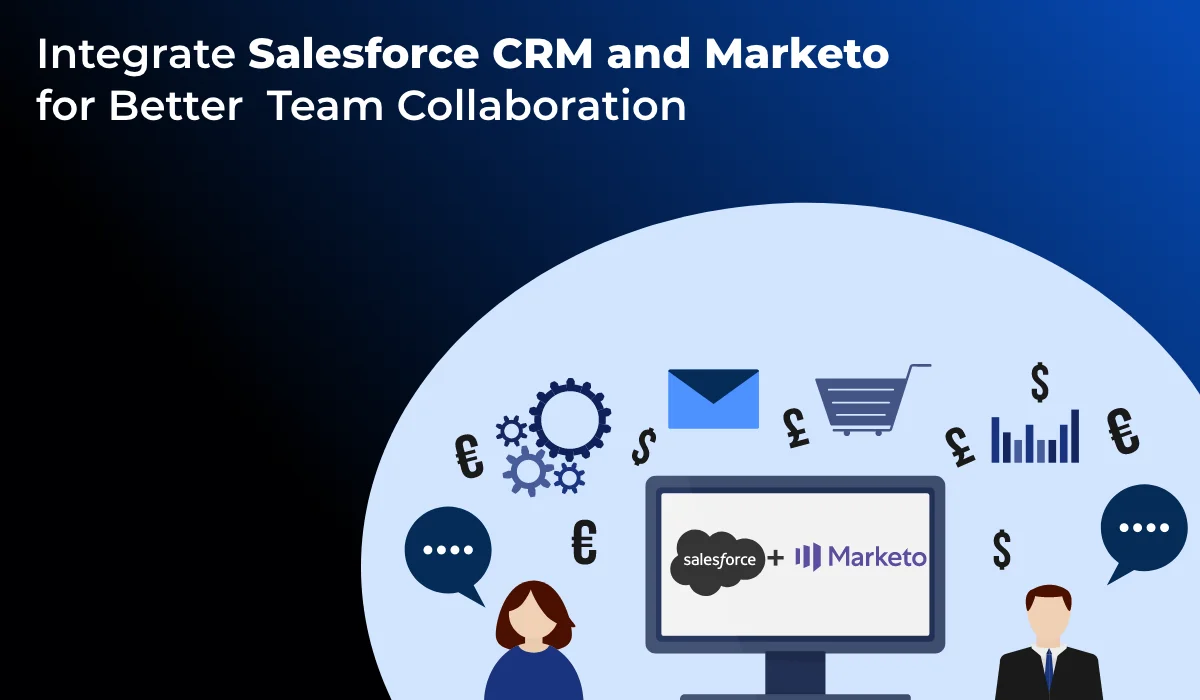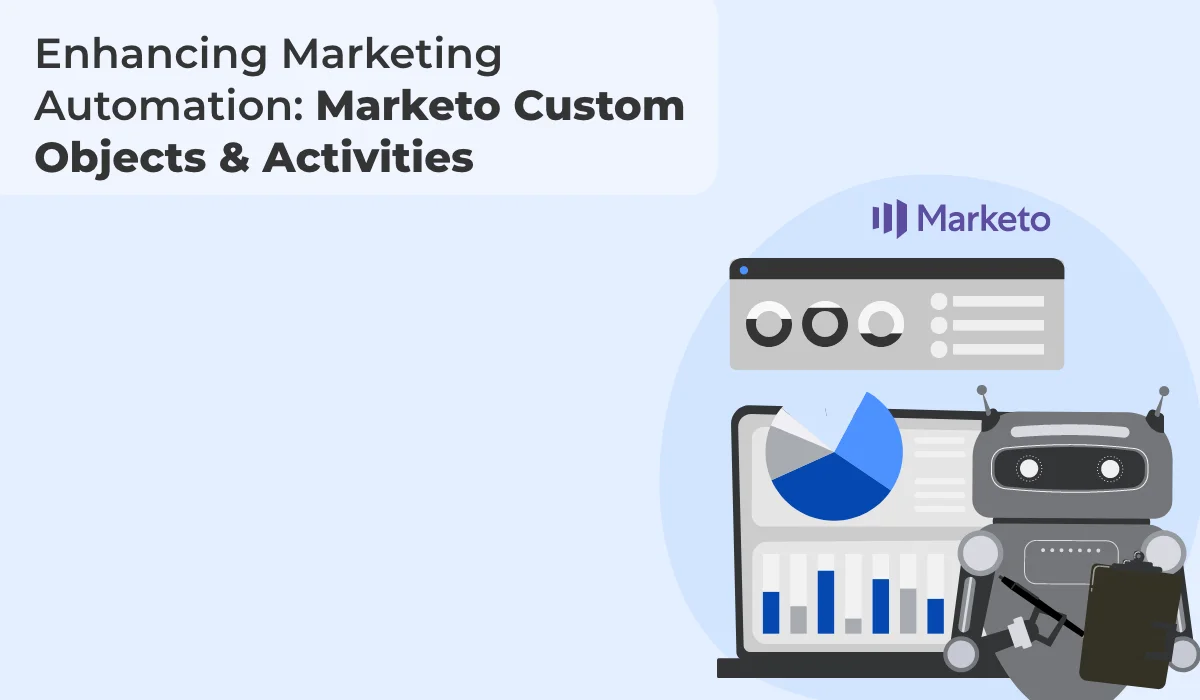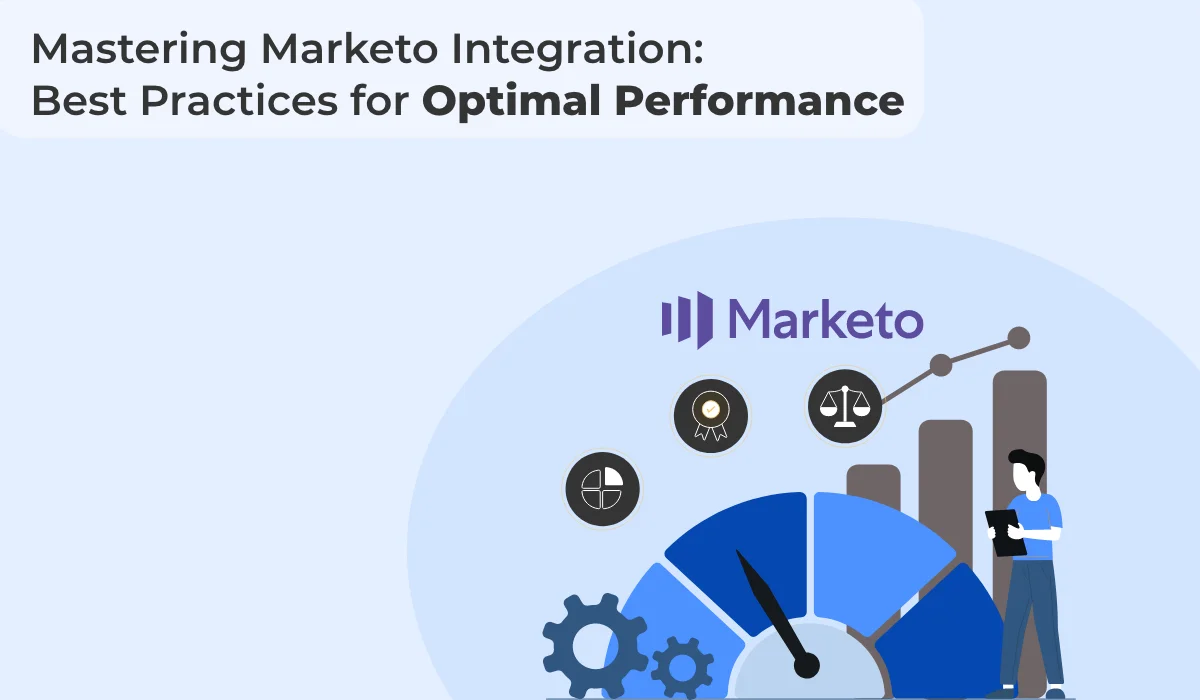Integrate Salesforce CRM and Marketo for Better Team Collaboration

Published on: November 10, 2021
Updated on: July 08, 2024
652 Views
- Marketo
7 min read
Delivering superior customer experience and converting customers into brand advocates are the new battlegrounds for modern businesses.
However, to deliver stellar CX, team collaboration is essential, and that requires effective data access for every team.
If you’re using Marketo as your marketing automation platform and Salesforce as your CRM platform, chances are you’re aware of the challenges that your teams encounter while switching between these platforms to access crucial data.
So, what’s the solution? Marketo and Salesforce CRM integration is the answer!
Integrating these two platforms will help you offer better visibility to your sales and marketing teams, shorten sales cycles, deliver consistent messaging across channels, and unify data management.
Let’s dive right in!
Benefits of Integrating Salesforce CRM and Marketo
Complete View of Customer Interactions
Integrating Salesforce and Marketo provides a holistic view of customer interactions and engagement across both marketing and sales touchpoints. By aligning customer data between the two platforms, businesses can:
- Gain a Complete View of Customer Behavior: Integrated data allows marketers and sales teams to understand customer preferences, interactions, and interests across various channels and touchpoints.
- Track the Customer Journey Comprehensively: Follow leads from initial contact to the final conversion, providing valuable insights into the effectiveness of marketing campaigns and the sales process.
- Optimize Lead Scoring and Qualification: Data synchronization enables real-time lead scoring and qualification based on prospect interactions, ensuring that sales teams focus on the most qualified leads.
Streamlined Marketing and Sales Processes
Integration between Salesforce and Marketo streamlines marketing and sales processes, leading to improved lead nurturing and higher conversion rates. Some key advantages include:
- Automated Lead Handoff: Real-time data synchronization ensures that marketing-qualified leads are seamlessly handed off to sales teams, reducing lead leakage and enhancing lead conversion.
- Personalized and Targeted Marketing: Integrated data allows marketers to deliver personalized content and targeted campaigns based on lead behavior and preferences, increasing engagement and response rates.
- Closed-Loop Reporting: Integration enables closed-loop reporting, allowing marketers to track the success of marketing efforts through the entire sales cycle, attributing revenue and ROI accurately.
Enhanced Lead Nurturing and Conversion
Integrating Salesforce and Marketo enables more effective lead nurturing and increases conversion rates by facilitating:
- Timely and Relevant Follow-Ups: Sales teams can access real-time data on prospect activities, enabling them to reach out to leads promptly with personalized communication based on their interests.
- Unified Customer Communication: Integrated data ensures that customers receive consistent and cohesive communication from both marketing and sales teams, enhancing their overall experience.
- Targeted Sales Efforts: Sales representatives can access lead behavior data from Marketo, enabling them to tailor their sales approach to specific customer needs and pain points.
Integrating Salesforce CRM With Marketo - What Does the Process Look Like?
To harness the full potential of these platforms and ensure a unified customer experience, integrating Salesforce CRM with Marketo is crucial. Here’s how you can do it.
Step 1: Integrating Marketo Fields with Salesforce
- Begin by signing in to your Salesforce account and navigating to the "Setup" option.
- Under the "Build" menu, select "Customize," then click on "Leads."
- Click on "Fields."
- Click "New" from the "Custom Fields & Relationships" section.
- Choose the appropriate field type and proceed by clicking "Next."
- Add Field Name, Label, and Length.
- Configure access settings, making sure to set roles to "Visible" and "Read-Only" for all relevant profiles, except for the sync user and system administrator profiles.
- Select the page layouts where the field should be visible.
- If you need to create additional custom fields, click "Save & New."
Step 2: Mapping Custom Fields
- Click on the "Setup" menu.
- Click on "Fields"
- Click on "Leads."
- Choose "Map Lead Fields" you can find it under “Lead Custom Fields and Relationships"
- Select the field you want to map and associate it with the corresponding contact custom field.
- Repeat this process for all custom fields you wish to map.
- Once complete, click "Save."
Step 3: Creating a Profile and Defining Permissions
- In Salesforce, navigate to "Setup" and then "Profiles."
- Click "New," opt for the "Standard User" type, and name the profile "Marketo-Salesforce Sync."
- Click "Save."
- Check the following to configure security permissions:
- Administrative Permissions: It includes API Enable, Manage Public Templates, Edit HTML Templates, and Manage Public Documents.
- General User Permissions: Edit Events, Tasks, and Convert Leads.
- Standard Object Permissions: Read, Create, Edit, and Delete
- Save your changes at the bottom of the page.
Step 4: Setting Field Permissions
- Visit the profile detail page and access Field-Level Security.
- Click "View" and provide accessibility.
- For each object, click "Edit" and uncheck "Read Access" and "Edit Access" for any unnecessary fields.
- Save your changes after each edit.
Step 5: Creating Your Marketo-Salesforce Sync Account
- In the "Manage Users" section, click "Users," and then select "New User."
- Fill in all the required fields.
- Choose the User License as "Salesforce" and assign the "Marketo-Salesforce Sync" profile you created.
- Click "Save."
Step 6: Configuring Sync Credentials
- Obtain your Security Token from Salesforce by logging in as the Marketo Sync User profile.
- In Salesforce, access "My Settings" and search for 'reset.'
- Click on "Reset My Security Token."
- Go to "Admin" in Marketo and click on "CRM."
- Select "Sync with Salesforce."
- Add your Security Token and then click on "Sync Fields."
- Confirm your credentials.
Step 7: Initiating the Sync
You're now ready to start syncing data!
- Click "Start Salesforce Sync" to initiate the Marketo-Salesforce sync.
- Select "START SYNC."
You have successfully set up the Salesforce-Marketo sync, streamlining data flow and enhancing your ability to deliver personalized customer experiences. Remember, this process might seem complex, but taking it one step at a time will ensure a smooth integration.
Best Practices to Follow While Integrating Salesforce CRM With Marketo
1. Define Clear Objectives
Before initiating the integration process, it's crucial to have a clear understanding of your goals and objectives. Define what you want to achieve with the integration, such as improving lead management, enhancing marketing automation, or streamlining data synchronization. Document your objectives to serve as a guiding framework throughout the integration process.
2. Establish Data Governance
Effective data governance is the foundation of a successful integration. Develop comprehensive data governance policies that address data quality, consistency, and security. This includes data cleansing, deduplication, and data standardization processes. Regularly audit and maintain your data to ensure its accuracy and reliability in both Salesforce and Marketo.
3. Foster Sales and Marketing Alignment
One of the primary purposes of integrating Salesforce and Marketo is to bridge the gap between your sales and marketing teams. Foster collaboration and alignment between these teams to create a seamless lead management process. Define clear lead scoring criteria, lead handoff procedures, and communication protocols. Encourage open communication to ensure both teams work towards shared objectives.
4. Thoroughly Test and QA
Testing is a critical phase of integration. Prior to deploying the integration in a production environment, conduct thorough testing in a controlled environment, such as a sandbox or staging environment. Test various scenarios, data synchronization processes, workflows, and automation. Identify and rectify any issues, ensuring that the integration functions as intended.
5. Document the Integration Process
Comprehensive documentation is essential for the long-term success of your integration. Create detailed documentation that includes data mapping, integration workflows, configurations, and any custom development. This documentation serves as a reference for troubleshooting, training new team members, and ensuring continuity in case of personnel changes.
6. Implement Ongoing Monitoring and Maintenance
Post-integration, it's crucial to establish a system for continuous monitoring and maintenance. Regularly monitor data synchronization processes, campaign performance, and lead scoring accuracy. Implement proactive maintenance to address any issues promptly. Stay informed about updates and new features in both Salesforce and Marketo, adjusting your integration to remain compatible and leverage new capabilities.
Conclusion
Integrating Salesforce CRM with your Marketo instance will help you understand the gaps and the friction points in your marketing and sales processes. So, integrate these two platforms to make your marketing and sales processes as effective as possible, shorten the sales cycles, and deliver stellar customer experiences.
Ready to Integrate Salesforce CRM and Marketo With Finesse? Let’s Talk!
If you need any help with the integration process, our experts will be happy to pitch in. Just drop us a line at info@growthnatives.com and we’ll take it from there!



